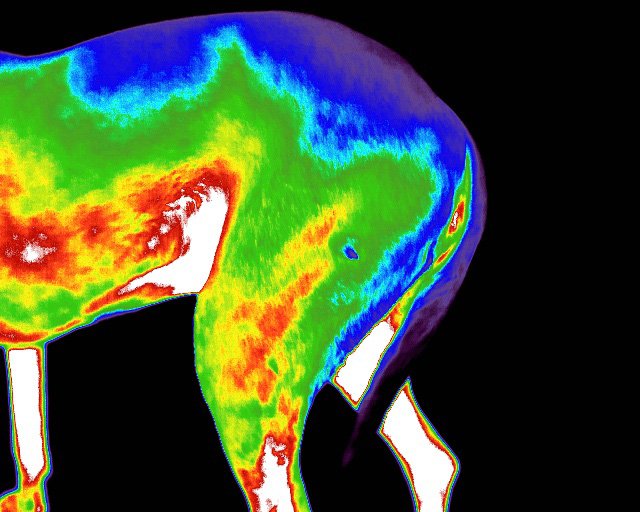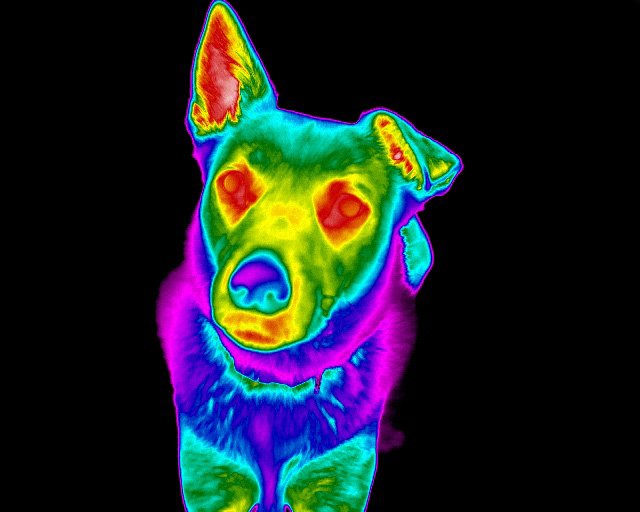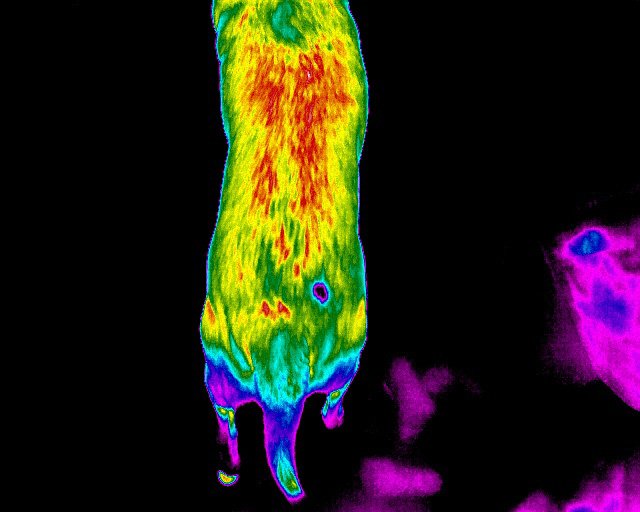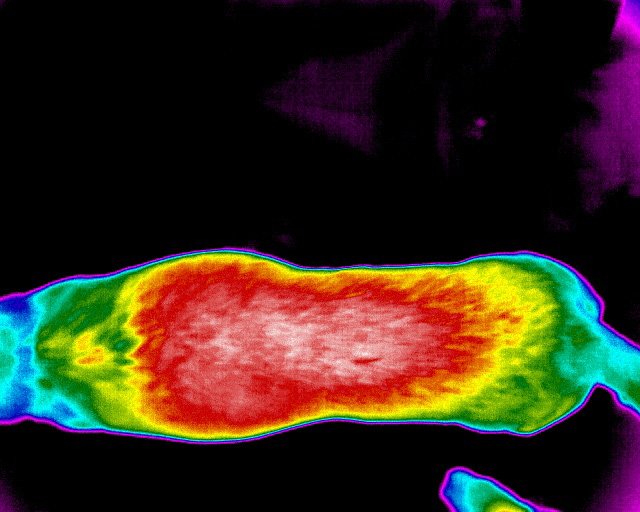What is thermal imaging?
Thermal imaging captures temperature differences and displays the results in an informative visual image. A hi-tech infrared detecting sensor is paired with sophisticated computer software to receive information about temperature changes and then process that into a colourful image. At Canine Body Balance, we use a high-end long-wave quantitative camera that can discern temperature differences as precise as 0.02°C, and it does so across over 327,000 pixels in every image.
Infrared thermography works by analysing the heat energy emitted or reflected from a body or surface. Specifically, a thermal camera captures information on heat radiation. This type of heat energy travels by energy waves in the infrared light spectrum from the hot object into the surrounding environment. These infrared energy waves have slight differences in wavelength and amplitude, allowing the device to ascertain body surface temperature quickly.
The wavelengths of infrared radiation fall outside our visible light spectrum, so we need to use infrared thermography to visualise animals' thermal profiles. Thermal imaging of animals is not a new science. However, its many veterinary applications and benefits are becoming more widely known in recent years.
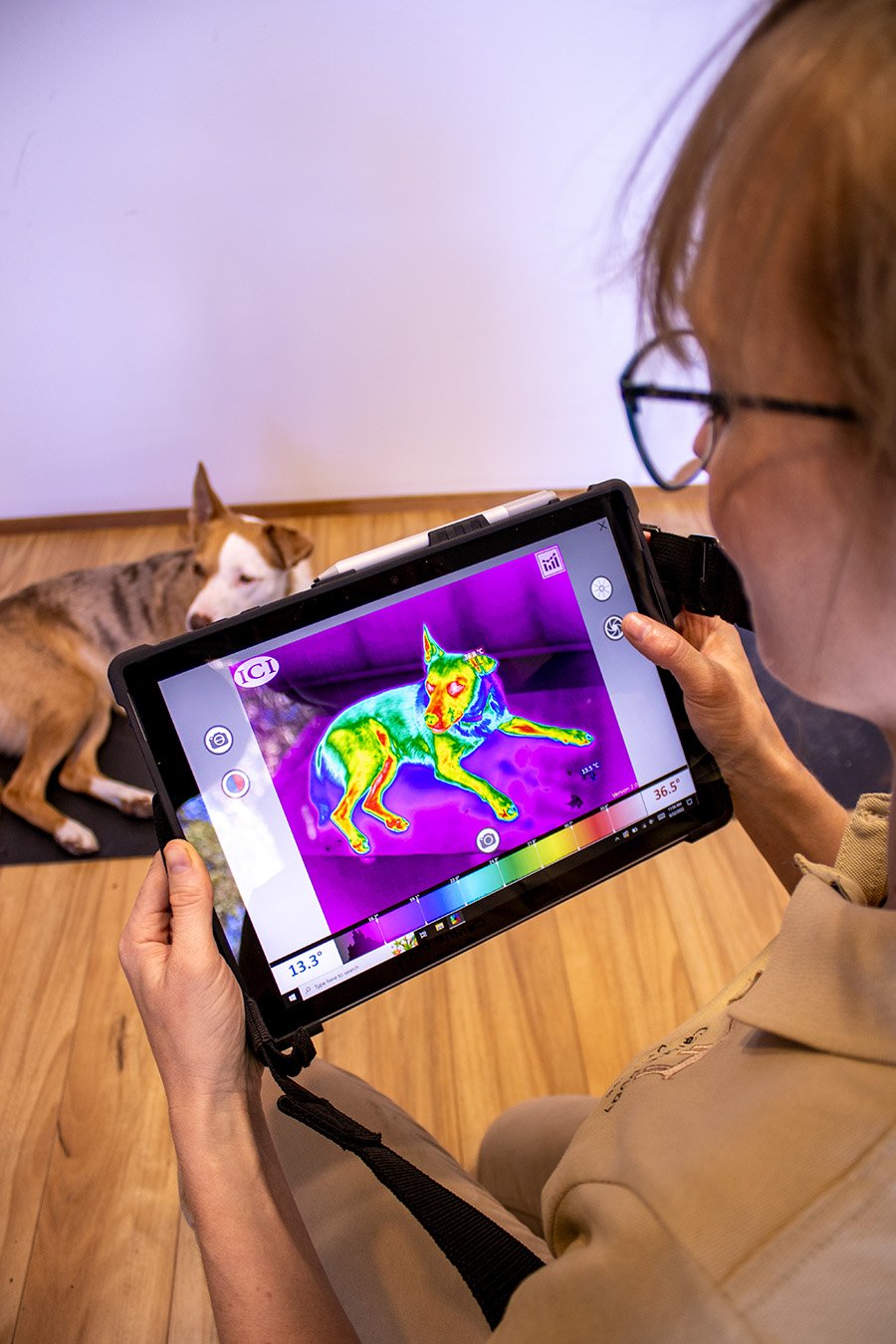
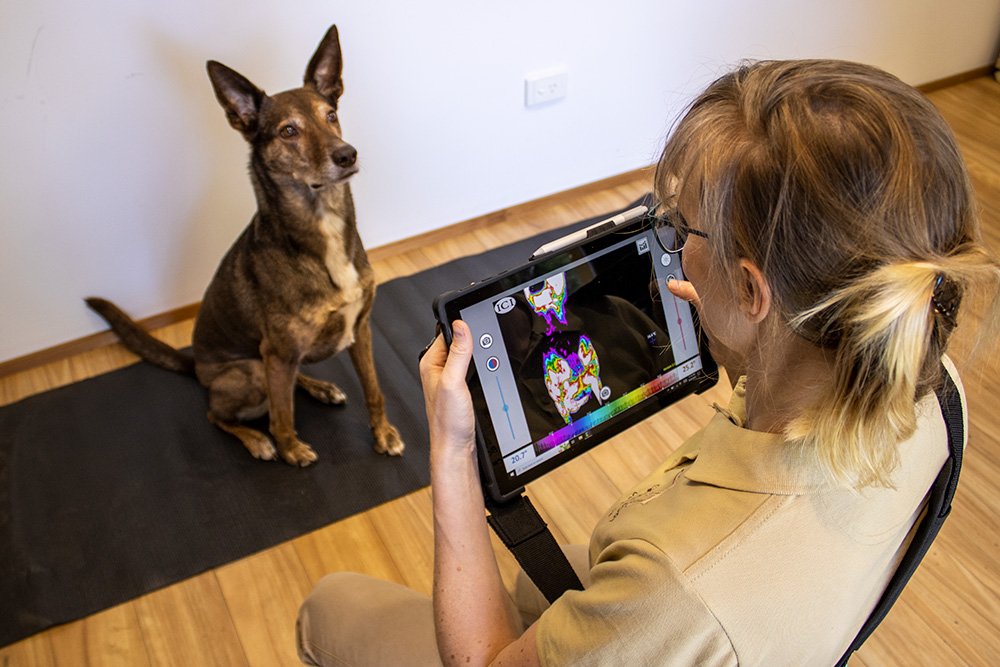
What is a Thermal Imaging Wellness Check?
The thermographer will take thermal images with our infrared camera during a wellness check. We then analyse those images for thermal symmetry and critical points of hyperthermia and hypothermia; this provides a clearer understanding of where our patients are suffering a level of disease or dysfunction such as; pain, injury from equipment use, overuse of muscles, restricted blood flow, etc.
The information gained from thermal imaging wellness checks can be used to guide a diagnosis or aid in the strategic delivery of treatments. It is an informative process that uses science to aid in distinguishing healthy dogs or horses from those with a range of ailments such as; acute muscle injury, limb and muscle blood supply variations, and compensatory muscle group overuse.
Once the Wellness Check report is generated, a copy is provided to owners. It can be further forwarded to your veterinarian or animal care team member at the owner’s request. Our Wellness Checks are designed to help optimise the care each animal gets. There is no harm to our patients as the process is non-contact and non-invasive; we can take as many images of the patient as is needed to gain clear insight.
The more we understand about our animals, the more informed we make health or welfare decisions for them.
Why conduct a Wellness Check?
There are many reasons to conduct a wellness check, from routine check-ups to monitoring rehabilitation. We encourage you to share your thermography report with your veterinarian and discuss findings with your animal health care providers and therapists.
If you want to know more about your dog or horse’s physiological state, then veterinary thermal imaging is a cost-effective option.
Here are some of the many reasons to conduct a wellness check through a certified veterinarian thermographer:
- General wellness checks for pet dogs or horses
- To aid in the delivery of effective targeted treatments
- Before manual therapy or hydrotherapy
- Before investigative radiography
- For canine and equine athletes who want higher levels of care or insight into their animal
- Dogs or Horses who present with lameness
- Animals with suspected neurological conditions
- Any biomechanical dysfunction
- To assist in maximising output from working dogs
- To detect or monitor muscle injury
- Equine saddle issues
- At Sporting events to improve animal welfare
- A whole body scan or analysis of a specific muscle group
Please note: if your animal is experiencing an emergency, you must call either an emergency veterinarian hospital or your primary veterinarian health care provider.
What is veterinary thermal imaging?
Veterinary thermography is a specialised service that helps owners and their animal care team better understand the physiological state of their horses and dogs. Thermography requires a skilful thermographer to take and analyse thermal images of your animal. At Canine Body Balance, we specialise in Canine and Equine thermography services.
Animals (and humans) emit infrared radiation from their bodies which is detected by the thermal camera. The process is non-invasive and non-contact. The infrared camera captures and processes the surface temperature of the animal's body.
The resulting images of the patient show areas of heat (hyperthermia) and regions that lack heat (hypothermia). Temperature differences are represented by colour and are scaled across the standard visual hues. Each patient has their own individual heat map, which changes depending on internal and external factors.
Our thermographers analyse the animal's thermal profile, looking for thermal asymmetries and abnormal body temperature differences, which can be a major indicator of dysfunction. This information provides impressive clarity of the animal's physiological state.
.
Benefits of Veterinarian thermography
Early detection
Thermal imaging is a powerful screening tool that can be used for the early detection of many dysfunctions within your animal. It is not a diagnostic tool; instead, it identifies areas that require attention and this information is passed to your animal health care team for evaluation, diagnostics and treatment. Canine Body Balance provides manual therapy services that may assist relieve your dog's neurofascial, soft tissue or muscular-skeletal dysfunction.
Early stages of diseases may not present clinical signs, and yet, changes in blood supply to affected areas are likely already underway. The infrared energy emitted by the animal is detected by the thermal camera, where minute changes in skin surface temperature differences can be analysed. The thermographic images display those thermal changes caused by altered blood flow to the area of concern. Monitoring these temperature differences may assist disease progression prevention through early detection and intervention.
The thermal patterns of healthy animals differ from those suffering from diseases; healthy animals display thermal symmetry associated with healthy blood circulation. Abnormal body temperature can signify the early stages of illness, injury, neurological dysfunction, and other ailments that alter blood flow.
Vasoconstriction, which correlates to neurological conditions, can show as areas of hypothermia. At the same time, injuries related to inflammation will have increased blood flow and show areas of hyperthermia.
Improve Animal Welfare
Veterinary thermal imaging can be used proactively for welfare assessment. Regular thermographic imaging allows us to monitor stress responses in the body surface temperature; this is especially beneficial for those wanting to monitor the response to treatments.
Physiological monitoring puts animal welfare at the forefront. Understanding the baseline physiologic status of individual animals allows you to monitor for changes before significant indicators become apparent through behavioural changes or clinical signs.
Cost-effective
The costs associated with thermal imaging can be much less than other imaging - however, that does not mean thermal imaging replaces them. This technology is often used before anatomical imaging such as; radiographs, ultrasound or more expensive MIRs to aid technicians and veterinarians in efficiently using these more invasive technologies.
Since thermal imaging is non-invasive and generally well tolerated, we can minimise costs and take as many images as needed without harm to the patient, allowing us to gain a clearer picture of the patient’s wellness.
We want our patients to receive the best care, and thermal imaging provides an objective means to assess and monitor their condition.
Monitoring
Healthy dogs have symmetry in their skin temperature, driven by even blood flow and the absence of hot spots. The beauty of conducting thermal imaging on animals is that we can measure normal variation and track changes through our physiologic monitoring program. Repeating thermal imaging on a weekly or biweekly bases is a great way to see how effective healing or rehabilitation has been.

Veterinary thermal imaging is a valuable tool
Canine and Equine thermography analyses the detectable skin surface temperature and presents the information in a colourful image. The location and pattern of these temperature differences can tell us a lot about underlying conditions.
Examples:
- Muscle injury may show up as a localised area of inflammation
- Joint disease may show up as inflammation in one or more joints
- Neurological conditions may show as areas of hypothermia as blood vessels constrict
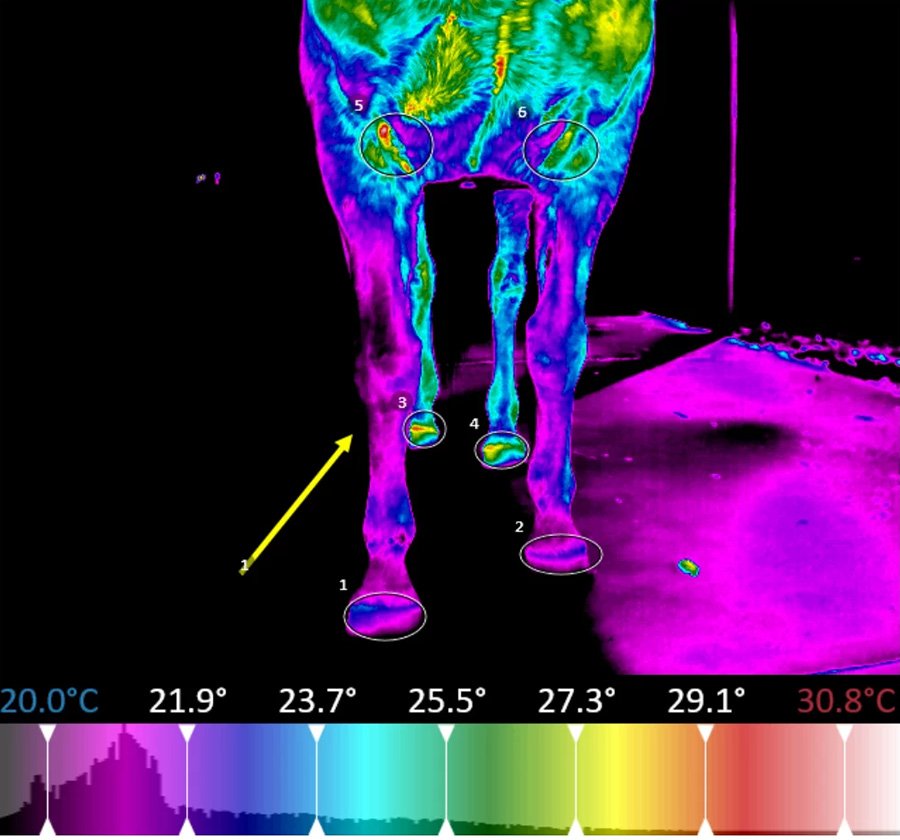
Who may benefit from Canine or Equine thermography?
Thermal imaging is a valuable tool for many applications; here is a list of reasons it may benefit you:
- Assist in optimising the performance of racing animals (greyhound/thoroughbred)
- Assist in targeting treatments (Bowen therapy/Massage/laser/etc.)
- Assist in wellness discussions with your veterinarian
- Monitor rehabilitation after surgery
- Identify areas of concern due to compensation
- Identify areas of concern with equipment fitting
- Require a non-invasive, non-contact assessment
- You’ve been unsuccessful in getting a diagnosis
- Biomechanics assessment
- and more
